Cirrus Logic was a graphics chipset manufacturer for the IBM PC and its compatibles. Founded in 1984 in Silicon Valley, their chipsets became very popular due to their low cost and high degree of compatibility. During the early 90s, when compared to other Windows graphics accelerator cards from Trident, Oak, and Paradise (Western Digital), the Cirrus Logic usually outperformed them all.
In 1991 the company acquired Crystal Semiconductor, an audio mixer/DSP chip company. In 1992 they bought AcuMOS, a video chipset company who designed and manufactured chipsets called "AVGA1" and "AVGA2". These were rebranded in late 1992 to the CL-GD naming format.
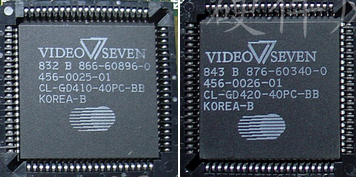 CL-GD410 / CL-GD420 CL-GD410 / CL-GD420
Launched: 1987
Bus: 8-bit ISA
The CL-GD410 and 420 was an ISA Super VGA chipset. This chipset can be found on the Video7 VEGA VGA card.
|
 CL-GD510 / CL-GD520 CL-GD510 / CL-GD520
Launched: 1988
Bus: 8-bit ISA
Memory: 256 KB DRAM
Supports: Hercules, CGA, EGA, MCGA, VGA
The CL-GD510 and 520 was an ISA Super VGA chipset, called "Eagle II". This chipset was known for its 100% hardware CGA emulation. Most cards that bore this chipset came with both 9-pin and 15-pin D-SUB sockets to support pre-VGA monitors and VGA/SVGA/Multisync monitors. The core was typically clocked at 40 MHz, as was the memory.
I have one of these cards - it is an almost full-length 8-bit ISA card that runs the Eagle II VGA chipset. I dumped the VGA BIOS v2.12 here (the file is 64 KB but I believe the Eagle II is just in the first 32 KB so you will need to edit the file to make it work for re-burning).
The Ultimate Oldschool PC Font Resource has this card's incredible font in its collection:

Used on the following graphics cards:
- MaxLogic MX675
- VIP VGP-II (no FCC ID)
- Morse KP800-16 (no FCC ID)
- VG-1000 (see below) - Award VGA BIOS Download courtesy of Andy Welburn incl. the images below
More Images
.jpg) .jpg)
|
 CL-GD5320 CL-GD5320
Launched: 1990
Bus: 16-bit ISA
Memory: 256 KB DRAM
Supports: SVGA
The CL-GD5320 was an ISA Super VGA chipset. These cards, since they were SVGA only, came with just the 15-pin D-SUB. The core clock ran at 40 MHz.
Found on the following graphics cards:
CL-GD532X Datasheet |
  CL-GD5401 CL-GD5401
Launched: 1992
Bus: 16-bit ISA
Memory: 256 KB only
The CL-GD5401 was an ISA Super VGA chipset, also branded as AcuMOS VGA, or AVGA1. AcuMOS were acquired by Cirrus Logic in 1992 who renamed their AVGA1 to CL-GD5401 and AVGA2 to CL-GD5402.
This was the first fully-integrated VGA chip to market (built-in RAMDAC and clock generators), meaning the only external chips required were video memory and a VGA BIOS.
They were sold on the basis of low price rather than high performance, but despite this, both the AVGA and its successor, the AVGA2 (CL-GD5402), are top performers!
Found on the following cards:
Some of these cards are 16-bit ISA but still work in an XT's 8-bit ISA slot in "compatibility" mode:
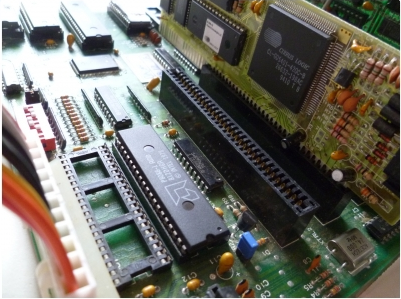
More Images
  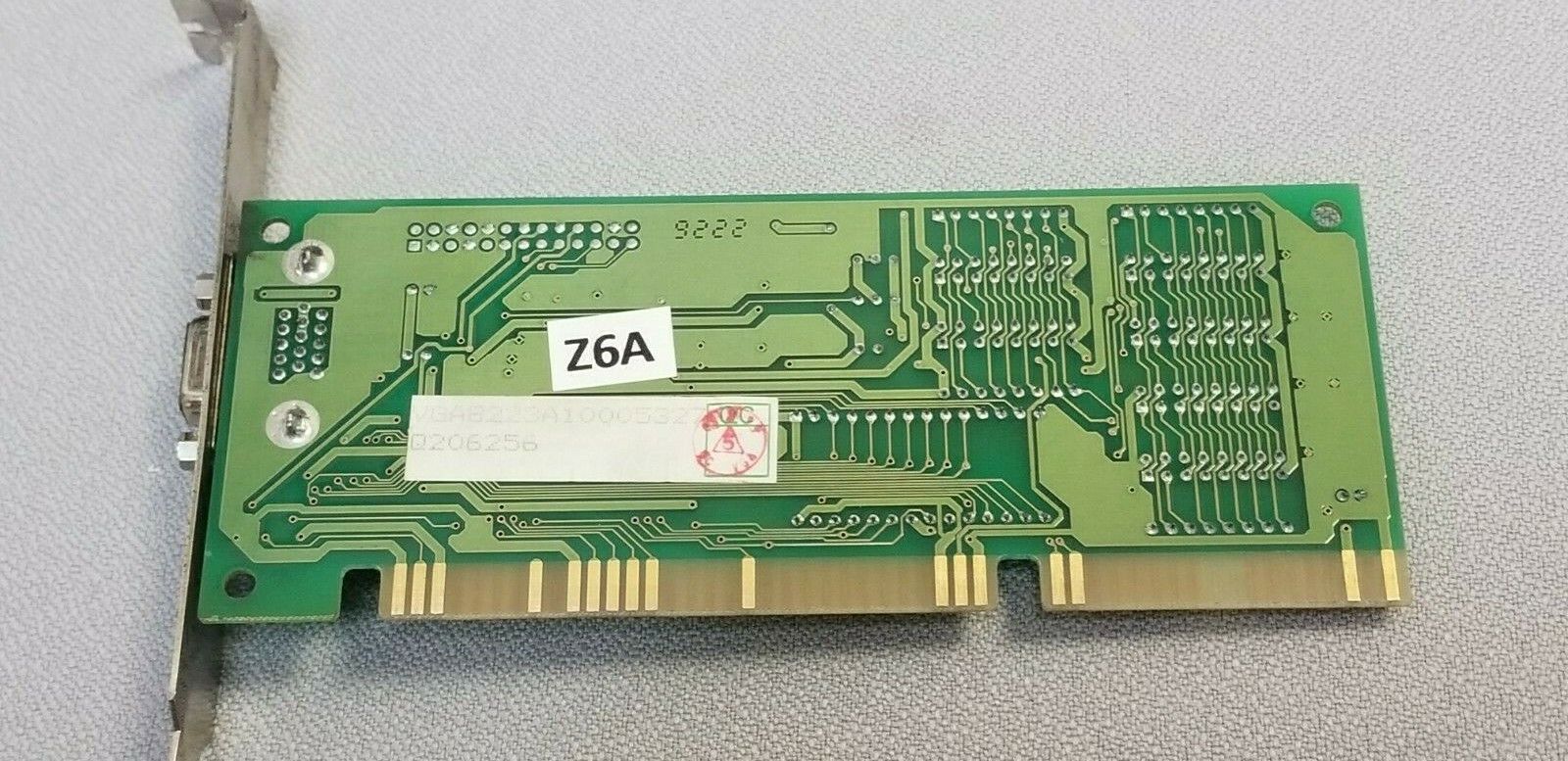 .jpg) .jpg)
|
  CL-GD5402 CL-GD5402
Launched: 1993
Bus: 16-bit ISA
Memory: 256 KB or 512 KB
The CL-GD5402 was an ISA Super VGA chipset, also branded as Acumos VGA, or AVGA2. AcuMOS were acquired by Cirrus Logic in 1992 who renamed their AVGA1 to CL-GD5401 and AVGA2 to CL-GD5402.
Like the AVGA1, the AVGA2 was sold on the basis of low price rather than high performance, but despite this, both the AVGA (CL-GD5401) and AVGA2 are top performers!
The AVGA2 chipset added support for up to 512 KB of video RAM over the AVGA1's 256 KB, which meant it could support all the AVGA1's video modes in addition to 640 x 480 in 256 colours, 800 x 600 in 256 colours and 1024 x 768 in 16 colours.
Commodore used the CL-GD5402 in their 386SX-25 computers.
Found on the following cards:
|
CL-GD5410
 Launched: 1991 Launched: 1991
Bus: 16-bit ISA
The CL-GD5410 was an ISA Super VGA chipset. It was installed on low-to-mid range DRAM-based cards (accelerated), and some laptops. It is known for being among the first to integrate the graphics card components into a single chip (built-in RAMDAC and clock generators). |
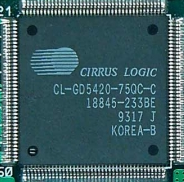  CL-GD5420 / 5421 CL-GD5420 / 5421
Launched: 1992
Bus: ISA 16-bit
Memory: 512 KB or 1 MB FPM
Memory Clock: 50 MHz
Core Clock: 75 MHz
The CL-GD5420 was an ISA Super VGA chipset. Highly integrated with an embedded 15-bit RAMDAC and PLL.
The CL-GD5421 is a minor upgrade as it had a 16-bit RAMDAC, also commonly referred to as High Color or "Hi-Color". There was never a 24-bit "True Color" DAC for the 5420/5421.
The core clock runs at 75 MHz, and memory at 50 MHz.
Found on:
- Octek AVGA-20 (EP20069R21)
- Ahead AVGA3B
- Kentech Computer (HK) Ltd (FCC ID: KJDKEN-CL542XVGA) - see pic above with 512 KB VRAM
- ATI VGA
- VAVGA31-5420-1M (a 1 MB card)
- Sigma Designs LG240
|
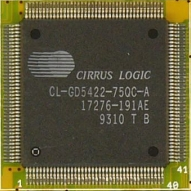  CL-GD5422 / 5424 CL-GD5422 / 5424
Launched: 1992
Bus: ISA 16-bit (CL-GD5422) or VLB (CL-GD5424)
Memory: 512 KB or 1 MB FPM
Memory Clock: 50 MHz
Core Clock: 80 MHz
The CL-GD5422 was an enhanced version of the CL-GD5420, with a 32-bit memory bus and 15/16/24-bit RAMDAC, so supported True Color (16.7 million colours).
It offered 1280 x 1024 interlaced or 1024 x 768 non-interlaced maximum resolution. The CL-GD5422 supported hardware acceleration for both 8-bit and 16-bit color depths. It was one of the lowest-priced SVGA controllers to support both. The core clock runs at 80 MHz, and memory at 50 MHz.
A VESA Local Bus version of the 5422 is called the CL-GD5424 - it was their first VLB card. There is at least one anomaly I've noticed - the Ahead AVGA-A3 card listed below is a 16-bit ISA card that uses the CL-GD5424. I guess the 5424 provides a VESA local bus width but is fully backward-compatible to run on the 16-bit ISA bus too, so if parts were in short supply, CL may have offered up 5424s in place of 5422s. Can anyone clarify?
Found on:
The CL-GD5424 was also the integrated VGA chipset used on AST Bravo 486 computers.
Datasheet
Images of a CL-GD5422 Evaluation Board, courtesy of Andy Welburn of AndysArcade:
.JPG) .JPG) .JPG) .JPG) .JPG)
Andy also provided the VGA BIOS ROM images: Odd, Even
and the disks' contents: Disk1, Disk2
|
 CL-GD5425 CL-GD5425
Launched: 1993
Bus: ISA 16-bit or VLB
Memory: 512 KB or 1 MB FPM
Memory Clock: 60 MHz
Core Clock: 80 MHz
The CL-GD5425 was the same as the CL-GD5424 but also got a TV out connector. This was able to scale a full VGA display (640 x 480) into a TV viewing area while maintaining a correct aspect ratio.
Datasheet |
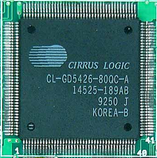 CL-GD5426 CL-GD5426
Launched: 1993
Bus: ISA or VLB
Memory: 1 MB or 2 MB FPM
Memory Clock: 50 MHz
Core Clock: 80 MHz
RAMDAC: 24-bit
The CL-GD5426 was the first Cirrus Logic chipset that got a 32-bit hardware BitBLT (bit block transfer) engine and also the first to support up to 2 MB of video memory. 15-pin D-SUB only.
Core clock runs at 80 MHz, memory at 60 MHz.
The ISA bus version could operate at up to 12.5 MHz while the VLB version ran at 50 MHz.
"Cirrus Logic, well-known for its GD5422 dumb frame buffer chip used in boards such as Sigma Designs' WinStorm and STB Systems' Evolution VGA, enters the video acceleration market with the Cirrus Logic GD5426. But the GL5426 sticks close by Cirrus Logic's frame buffer roots by performing best in DOS video modes.
The GD5426 doubles the Graphics Winmark performance of its non-accelerated sibling at some resolutions and color depth, but the problem is that the GD5426 still lags behind when measured against Windows performance of much of the accelerator competition.
The GD5426 boards we tested managed only 4.04 to 4.14 megapixels per second in 16-color Super VGA and 4.41 to 4.60 in 16-color 1,024-by-768 mode tests, for example, while [S3] 86C801- and 86C928-based products racked up average scores of 10 megapixels per second in these modes. (Even the 86C924 chip outdid the GD5426: the boards using that chip scored around 7 megapixels per second).
At 256 colors in Super VGA and 1,024-by-768 resolutions, the GD5426-based cards scored close to or a little better than 8 megapixels per second, but those scores still did not come close to those achieved by most of the 86C801-based or 86C928-based competition (which scored around 12 to 14 megapixels per second).
All the GD5426 boards we saw used a 16-bit ISA hot bus interface. According to Cirrus Logic, the chip itself delivers 32-bit access to display memory and also has a 32-bit internal data path for Extended Industry Standard Architecture (EISA) or local-bus solutions.
Part of the reason GD5426-based boards can't keep up is that the chip accelerates only BitBlts, image transfers and raster operations. And while the company says that the chip provides for font caching, none of the boards we tested for this review supported that feature." PC Magazine, April 1993
Found on:
- Diamond SpeedSTAR Pro ISA (FCC ID: FTUISA5426A)
- Genoa Systems Windows VGA 24 Model 8500/VL
- Hightech Information System (HK) Ltd (FCC ID: KBIA3U5428)
- ASUS GMIO-470
- Octek VL-COMBO (Part no. EP40084R32)
- Boca Research SuperX Accelerator VGA
- Cardinal Technologies VideoSpectrum XL
- Edge Technology D24 BitBlaster Plus (Edge Technology became Micron Computer, Inc. in 1993)
- DTK PTI-240A VESA VGA (FCC ID: F825K4PTI240)
- RT-3501-1 (FCC ID: I4L3405)
- Pine PT-2036 (FCC ID: H52-PT-2036)
- Octek AVGA-26 (Part no. EP20073R11)
- Octek(?) AVGA-3VL (Part no. MVGA-AVGA3VL)
- RL-3503-2
- Cirrus Logic (FCC ID: J6N4LVLDM7)
- Pine PTI-5426-VL (FCC ID: PTI 5426VL)
- Whole In One
- Aquarius Systems Inc (FCC ID: GPLAPC-5426)
- Magitronic (FCC ID: JDF-VGA-VL5426)
- FIC (First International Computer) FCC ID EUNVGA-542V
- ASL Lightning2 / Alpha Systems Lab (FCC ID: JSQASLWACJJMP)
Datasheet |
 CL-GD5428 CL-GD5428
Launched: 1993
Bus: ISA (16-bit) or VLB
Memory: 1 MB or 2 MB VRAM or FPM
Memory Clock: 50 MHz
Memory Sockets: Typically 20-pin DIP
Core Clock: 80 MHz
RAMDAC: 24-bit
The CL-GD5428 was an enhanced version of the CL-GD5426 with a faster BitBLT engine. Core clock runs at 80 MHz, memory at 50 MHz.
Found on:
- SPEA / Video7 Vega
- Diamond SpeedSTAR Pro VLB (FCC ID: FTUVL5426A)
- Octek VL-VGA-28 (EP20094R11)
- Pine PT-524/8G
- EliteGroup / ECS VI-710/711 (FCC ID: H9NVI710)
- VGA GUI 2100 (FCC ID JPM2100VIDE)
- UTD-01B Cl542X VESA Local Bus (FCC ID: J6Q4LVLDM7)
- Palm VL-Bus (FCC ID KGBPALMVL)
- ST242X-VL4 (FCC ID J6N4LVLDM7)
- Gainward (FCC ID: ICU VGA-GW 143B)
- GP-3200
- AGATech Corp (Taiwan) PWA-MVA-542X (FCC ID:
JCC MVGA-524X)
- Cirrus Logic P202 (FCC ID J6N4LVLDM7)
- DFI WG-1000VL/4
- Hightech Information System (HK) - FCC ID KBIA3U5428
- Ambition Technology Co Ltd (Taiwan) - FCC ID: I7EAB-5426VL
- Protac International Corp (Taiwan) - FCC ID: J4UVGA826WVLC3
- Chain Plus Information Inc (Taiwan) - FCC ID: LII5428BVL
- Boca Research (USA) - FCC ID: EUD 5U9 BRI461Q
- Quantum Designs (HK) Ltd - FCC ID: KDECIRRUS5426VL
- Palit Microsystems Inc (Taiwan) - FCC ID: KC8PM-V116
Datasheet |
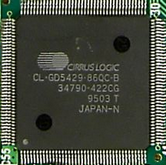 CL-GD5429 / CL-GD5430 CL-GD5429 / CL-GD5430
Launched: 1994
Bus: ISA, VLB or PCI
Memory: 512 KB, 1 MB or 2 MB FPM
Memory Clock: 60 MHz
Core Clock:
86 MHz
The CL-GD5429 was an enhanced version of the CL-GD5428 that first appeared in the first quarter of 1995 - the first in their new "Alpine" series of chips. These were typically found on VESA Local Bus and PCI graphics cards, but Diamond Multimedia used the chip on some of its later SpeedStar Pro ISA cards which usually used the older CL-GD5426.
What is new over prior GD-542x chipsets is the 5429/30 now support a higher memory clock speed (32-bit memory bus) and has memory-mapped I/O. They also have a 32-bit BitBLT engine.
The CL-GD5430 is similar to the 5429, but has a 543X core with its 32-bit host interface. Only slightly faster than the 5428.
Found on the following:
- Diamond SpeedSTAR SE VLB
- Cirrus Logic (FCC ID J6NGD543XPCI)
- ProLink MVGA-AlpinePCI
- Fastware VC921DS (CL-GD5430, 2 MB PCI)
- Some EliteGroup VI-720 (also used the later CL-GD5434)
Datasheet |
 CL-GD5434 / 5436 CL-GD5434 / 5436
Launched: 1994
Bus: ISA, VLB and PCI
Memory: Up to 4 MB
Memory Clock: 60 MHz (5434) or 80 MHz (5436)
Memory Sockets: Typically 40-pin SOJ
Core Clock: 135 MHz
RAMDAC: 15/16/24-bit
The CL-GD5434 was part of the "Alpine" family of chips, now with a 64-bit internal memory interface. Only supports 64-bit mode if equipped with 2 MB memory. Commonly equipped with 1 MB. 32bpp True Color support, it also had a 64-bit BitBLT engine. Only the CL-GD5434 was also available on the ISA bus.
The CL-GD5436 was simply an optimized version of the 5434, adding support for EDO DRAMs thus supporting a faster memory clock. Packed-24 acceleration.
Found on:
- Diamond SpeedStar 64
- Diamond SpeedStar Pro SE
- Orchid Kelvin 64
- MVGA Alpine PCI
- Fastware VC922C
(CL-GD5434)
- Intel Corp - FCC ID: EJMPCICL543X
- Powertech Electronic Co Ltd VCC34 (FCC ID: KEGPTPCIVGA3A)
- American DataCom Inc - FCC ID: IFTGD543XPCI
- Gainward Co Ltd (Taiwan) - FCC ID: ICUVGA-GW203
- Cirrus Logic - FCC ID: J6NGD543XPCI
Datasheet
|
CL-GD5440
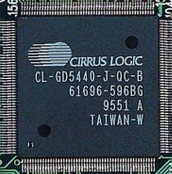 Launched: 1995 Launched: 1995
Bus: VLB or PCI
Memory: 512 KB, 1 MB or 2 MB FPM
Memory Clock: 60 MHz
Core Clock: 86 MHz
RAMDAC: 24-bit
The CL-GD5440 was essentially a CL-GD5430 with an integrated CL-PX2070/'85 motion-video acceleration chip (CL-GD54M40 has integrated filters). The core clock runs at 86 MHz, the memory at 60 MHz.
Found on:
- Joytech Computer Co Ltd (Taiwan) - FCC ID: FQI54X62L
Datasheet
|
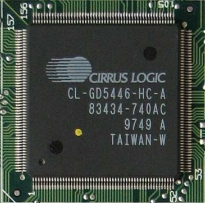 CL-GD5446 CL-GD5446
Launched: 1996
Bus: PCI
Memory: 1 MB or 2 MB EDO
The CL-GD5446 was a 64-bit Alpine VisualMedia accelerator. 2D-only. It added motion-video acceleration to the CL-GD5436.
Found on:
- STB Nitro 64V
- Joytech Computer Co Ltd - FCC ID: FQI54X62L
- FVGAP-CL8
- SR-V641-E
- Palit Microsystems Inc Daytona 64E (FCC ID: KC8GUIVGAS1)
- Hightech Information System Ltd (HK) - FCC ID: KBIGD544XP
|
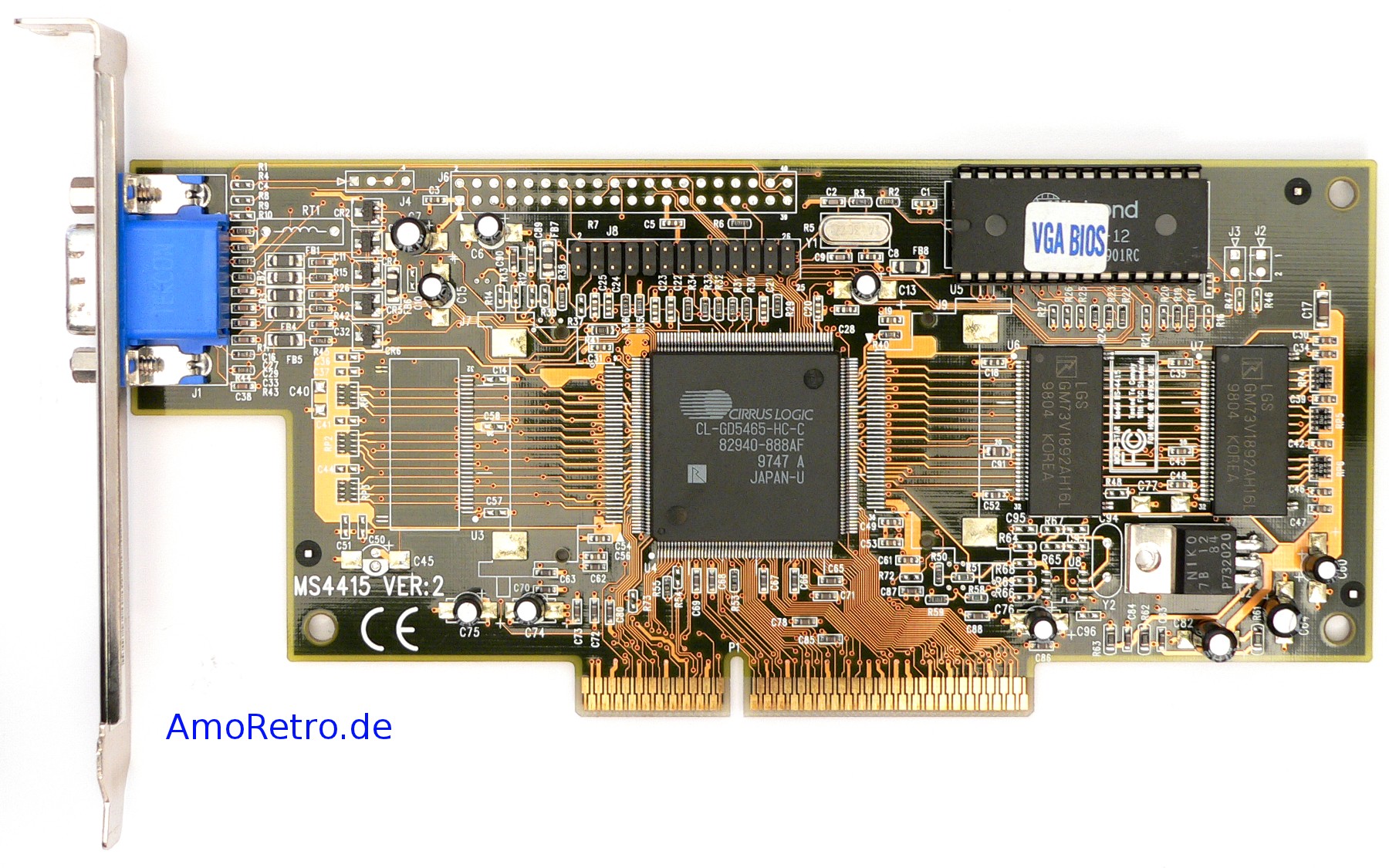 CL-GD546X CL-GD546X
Launched: 1995
Bus: AGP
Memory: ?
The Laguna VisualMedia family of 2D, 3D, and video accelerators. the CL-GD5464 and CL-GD5465 included 3D acceleration (PCI or AGP). These chips use a single channel of RDRAM memory, providing up to 600 MB/s bandwidth. The '62 lacks 3D acceleration. All include a BitBLT engine, video windows, and 64×64 hardware cursor.
"Cirrus Logic claims it has the graphics accelerator equivalent of the Jaguar XJ220 on its hands. Its new VisualMedia accelerator, "catchily" named the CL-GD5462, can shift a whopping 500Mb of data around every second.
The device is crammed with technology which enables it to handle video and 3D work at jaw-dropping speeds. It numerous features include line and polygon drawing acceleration, hardware zooming, a 64-bit graphics engine and direct conversion from the different colour palettes found in film sequences to those used on PCs." PC Review, Iss.47, September 1995
Found in MSI motherboard add-in, MS4415 and ExpertColor Laguna 5000. |
 CL-GD5480 CL-GD5480
Launched: ?
Bus: ?
Memory: ?
The CL-GD5480 was a 64-bit Alpine accelerator with 100 MHz SGRAM. |
 Cirrus Logic
Cirrus Logic


.jpg)
.jpg)







.jpg)
.jpg)


 Launched: 1991
Launched: 1991



.JPG)
.JPG)
.JPG)
.JPG)
.JPG)








